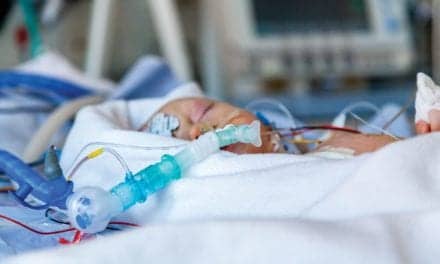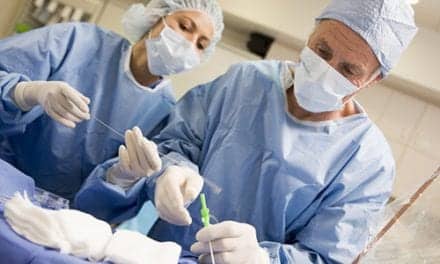Despite improvements in surgical technique to limit tissue trauma in chronic rhinosinusitis patients, postoperative challenges can limit endoscopic sinus surgery outcomes, including scarring or stenosis of surgical opening and recurrent inflammation and polyposis.
By Joshua Scharf, MD, FACS
Chronic rhinosinusitis (CRS) is a common inflammatory disease of the nasal and paranasal sinuses that affects approximately 12% of the US adult population, or 29 million people.1 Also called chronic sinusitis, CRS is one of the most common chronic diseases in the United States and is even more prevalent than heart disease and asthma.
A subgroup of chronic rhinosinusitis patients do not benefit from standard medical therapy and qualify for endoscopic sinus surgery (ESS).2 In the UK, approximately 15% of CRS patients undergo surgery yearly after failing medical treatment.3 Although surgical treatment of CRS is well-established and has been increasing since its inception in the 1980s, there is an unmet need for postoperative care options to significantly improve surgery outcomes.
Postoperative treatment to reduce inflammation and scarring after ESS is critical. However, procedures offered and performed for postoperative care have varying levels of success and safety. This article will take a close look at the challenges of controlling postoperative inflammation and treatment options, including an innovative technology that physicians can use to manage patient outcomes.
About Chronic Rhinosinusitis
CRS is a common inflammatory condition in which the nasal and paranasal sinus mucosa becomes swollen and inflamed leading to debilitating and persistent symptoms for at least 12 weeks.4 Common symptoms may include may include drainage of excess mucus, nasal blockage or congestion, difficulty breathing, pain and tenderness around the eyes, cheeks, nose and forehead, a reduced sense of smell and taste, fatigue, and irritability.5 Patients may also have other inflammatory airway conditions like asthma and allergic rhinitis.6 In addition, certain genetic and environmental conditions may predispose patients’ increased severity of symptoms.7
These persistent symptoms can have profound effects on the functional well-being and general health related quality of life. Chronic fatigue is commonly reported in patients with CRS. Depression is also a prominent factor that impacts overall quality of life in patients with CRS. Prevalence rates for depression in CRS patients range from 11-40%.8
Causes and Risk Factors
CRS is a multifactorial disease and is believed to arise primarily from persistent inflammation of the mucosa. Despite the prevalence of CRS, the exact cause of inflammation remains elusive. Inflammation may be the result of allergies, especially allergies from inhaled dust, mold, pollen, or the spores of fungi; irritants in the environment; and infections caused by fungus, bacteria, or viruses.8
Genetic, anatomical, and environmental factors, and comorbid disease are potential risk factors for CRS.Polyps, nasal tumors, and nasal fractures can obstruct sinus drainage leading to CRS. CRS can also present in patients with structurally narrow nasal passages. Patients with asthma, cystic fibrosis, or immune system dysfunction tend to develop CRS more frequently
Diagnosis
CRS is diagnosed based on duration of symptoms (at least three months) and physical examination to confirm signs of infection or inflammation. In addition to history and physical examination, diagnostic imaging, such as computed tomography (CT) scan or magnetic resonance imaging (MRI) of sinuses, may be ordered if diagnosis is unclear.
Management of CRS
Treatment of CRS is focused on reducing mucosal inflammation. In patients with mild CRS symptoms, first line therapy is medical management involving saline irrigation, anti-inflammatory steroids, and decongestants. For patients with moderate to severe CRS or when first line treatment is unsuccessful, a short course of oral steroids and/or antibiotics may be prescribed. Since many patients with CRS have allergies, asthma, and other comorbidities that contribute to CRS, concurrent treatment of comorbid disease is extremely important in order to provide comprehensive care to patients.
New immunomodulating drugs, which target and suppress specific drivers of inflammation in the immune system, have recently been approved to treat symptoms of CRS. Though they may work well in some patients to treat symptoms, high cost and the need for regular injections for an indefinite period of time are two major concerns among physicians.
Often, CRS is managed by a combination of medical management and surgical intervention. Patients whose symptoms persist despite medical management may undergo ESS, which has been useful in the treatment of CRS.
Endoscopic Sinus Surgery (ESS)
The goal of ESS has evolved over the years. Traditionally, ESS is performed to ventilate obstructed sinus cavities in patients with CRS. However, ESS is also used to debride inflamed tissues in order to remove dysfunctional epithelium driving inflammation in CRS. More recently, ESS is being used to provide greater access for more targeted delivery of topical medications to treat inflammation.
Though surgery is clinically effective, the majority of patients experience recurrent symptoms which require additional treatment with medications and additional surgical procedures.9,10 Challenges that arise during surgery are often specific to the paranasal sinuses (maxillary, frontal, and ethmoid) and can be minimized with postoperative care.
Management of Postoperative Inflammation
Postoperative care is an equally important aspect of surgical treatment. Complications can be compromised by postoperative inflammation, polyposis, and adhesions, often requiring subsequent interventions.11 Research has shown that reducing inflammation early on can reduce the need for postoperative interventions in patients. However, procedures used for postoperative follow-up, including rinsing with saline solution, suction of paranasal sinuses, topical, and oral/systemic steroids have varying levels of success and safety.
Topical, oral, and systemic treatments, especially corticosteroids, have been shown to improve management of CRS postoperatively. Topical steroids are typically safe due to their low amount of local, regional and systemic bioavailability. However, effective drug delivery with topical steroids varies due to both difficulty delivering therapeutic levels to the sinus mucosa and patient compliance. While oral and parenteral steroids carry significant short and long-term risks, such as elevation of blood glucose levels, cataract formation, mood changes, osteoporosis, and osteonecrosis.12
Addressing the Drug Delivery Challenge in the Sinus Mucosa
Over the years, new devices and techniques for ESS have helped improve patient outcomes. To address the challenges of drug delivery in the sinus mucosa, innovators developed a small, dissolvable and bio-compatible implant coated with corticosteroid, mometasone furoate.
Clinical evidence has demonstrated the utility of the implants in managing postoperative inflammation to promote healing in the paranasal sinuses, including the frontal, hard-to-reach maxillary, and ethmoid sinuses. In addition, research with the implants showed significant reductions in postoperative interventions in patients.13
Implants were specifically designed to conform to the sinus ostia, focusing drug delivery and mechanical support required in order to maximize sinus surgery outcomes. They feature a low-profile flexible delivery system to access tight areas of the sinus anatomy and deliver 370 µg of mometasone furoate over 30 days.
The implants are FDA approved and are intended for use following sinus surgery to locally deliver steroid to the sinus mucosa, reducing the need for postoperative intervention and the use of oral/systemic steroids.
Recommendations for Using Mometasone Furoate Implants
The introduction of the mometasone furoate eluting implants has led to meaningful benefits for physicians managing CRS patients, helping to prevent complications.
Physicians have reported success with the implants across different types of CRS patients, ranging from those with diffuse nasal polyps to patients with significant inflammation, narrowed nasal cavities, and anatomic variation that may lead to premature narrowing. Cases in which there are few signs of inflammation and ESS results in wide antrostomy and open ethmoid cavity, sphenoid ostia, or frontal ostia may not benefit from the implants.
Due to the innovative design of the implants, physicians have found the implants beneficial in maintaining large ostia, especially in the smaller sinus openings like the maxillary and frontal sinuses. The implants ensure that the newly opened sinuses remain open and inflammation is controlled. In addition, the implants are easy to place and manipulate, extremely safe, and add little to the overall time of surgery.
Patients generally find treatment with the implants tolerable and are often pleased with the results of ESS. The implants may cause an increase in postoperative pain and/or pressure, so physicians should also take into consideration whether pain will be difficult to control when determining whether a patient is an appropriate candidate for the implant.
Conclusion
Despite improvements in surgical technique to limit tissue trauma, postoperative challenges can limit ESS outcomes, including scarring or stenosis of surgical opening and recurrent inflammation and polyposis. Local drug delivery can improve outcomes for CRS surgery by addressing the underlying inflammatory process during the postoperative healing period.
Steroids are clinically effective in reducing postoperative complications due to inflammation. However, both topical and systemic delivery of steroids have varying levels of efficacy and safety.
Mometasone furoate implants solve the drug delivery challenge, delivering a consistent and sustained release of steroid. Results have demonstrated that the implants reduce the need for oral/systemic steroids and prevent postoperative complications in CRS patients. The implants should be considered by physicians whose CRS patients are candidates for ESS to improve surgical outcomes.
RT
Joshua L. Scharf, MD, FACS, is a board-certified otolaryngologist practicing at Main Line Ear, Nose, and Throat in Wynnewood, Pa. For more information, contact [email protected].
References
- Chronic Sinusitis. Centers for Disease Control and Prevention website. Reviewed February 21, 2020. Accessed December 16, 2020. https://www.cdc.gov/nchs/fastats/sinuses.htm
- Rudmik L, et al. Early postoperative care following endoscopic sinus surgery: an evidence-based review with recommendations. Int Forum Allergy Rhinol. 2011;1(6):417-30.
- Javanbakht M, Saleh H, Hemami MR, et al. A Corticosteroid-Eluting Sinus Implant Following Endoscopic Sinus Surgery for Chronic Rhinosinusitis: A UK-Based Cost-Effectiveness Analysis. Pharmacoecon Open. 2020;4(4):679-686.
- Orlandi RR, Kingdom TT, Hwang PH, et al. International Consensus Statement on Allergy and Rhinology: Rhinosinusitis. Int Forum Allergy Rhinol. 2016;6(suppl 1):S22-S209.
- Chronic Sinusitis. Mayo Clinic. Reviewed June 1, 2019. Accessed December 16, 2020. https://www.mayoclinic.org/diseases-conditions/chronic-sinusitis/symptoms-causes/syc-20351661
- Bachert, C, Marple, B, Schlosser, RJ et al. Adult chronic rhinosinusitis. Nat Rev Dis Primers. 2020;6(1):86.
- Min JY, Tan BK. Risk factors for chronic rhinosinusitis. Curr Opin Allergy Clin Immunol. 2015;15(1):1-13. doi:10.1097/ACI.0000000000000128.
- Orlandi RR, Kingdom TT, Smith TL et al. International Consensus Statement on Rhinology and Allergy: Rhinosinusitis. Int Forum Allergy Rhinol. Published online November 24, 2020. doi:10.1002/alr.22741.
- Ramadan HH. Surgical causes of failure in endoscopic sinus surgery. Laryngoscope. 1999;109(1):27-29.
- Otto KJ, DelGaudio JM. Operative findings in the frontal recess at time of revision surgery. Am J Otolaryngol. 2010;31(3):175-180.
- Han JK, Marple BF, Smith TL et al. Effect of steroid-releasing sinus implants on postoperative medical and surgical interventions: an efficacy meta-analysis. Int Forum Allergy Rhinol. 2012;2(4):271-9.
- Matheny KE. Bioabsorbable steroid-releasing sinus implants in the frontal and maxillary sinuses: 2-year follow-up. Allergy Rhinol. 2015; 6(2): e118–e121.
- Bhattacharyya, N. Symptom Outcomes After Endoscopic Sinus Surgery for Chronic Rhinosinusitis. Arch Otolaryngol Head Neck Surg. 2004;130(3):329-333.










